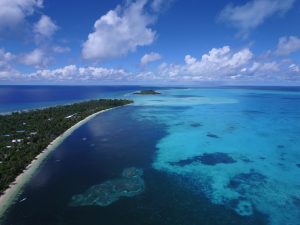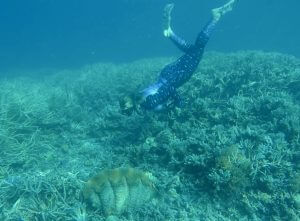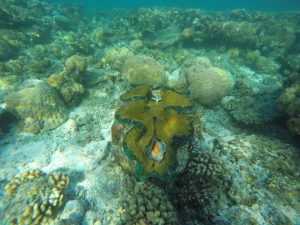Did a Giant really create Palau? The origin of the islands of Palau as told by Palauan forefathers and as is commonly known today, starts with a giant creature that lived on the ocean floor at Lukes, a shallow reef in the south between Peleliu and Angaur states. The Giant sat silently and grew each day. One day, the Giant spat out a baby that landed on the island

of Angaur. Some say the baby was a boy and others say it was a girl. Uab, as the baby was referred to, grew rapidly. One day for Uab was equivalent to one year for everyone else. His overwhelming appetite grew quickly each day, which alarmed the people of Angaur who thought Uab would consume all of the food on their small island. Consequently, the chiefs and elders of Angaur gathered the community and made plans to end Uab’s life out of fear of the Giant’s uncontrollable appetite. One night as Uab slept, the people of Angaur collectively piled up a large quantity of firewood around him and let the huge bonfire consume the Giant. His remains are said to have scattered into pieces across the ocean north of Angaur, forming the majestic southern lagoon and the rest of what we know today as Palau.
This oral history of Palau’s formation and the story of Uab has been told by Palauan elders across generations to teach Palauan children about managing the scarce resources on a small island such as Palau. Embedded in this tale, is the origin and underlying principles of Palauan traditional resource management principles and practices. Respect and reciprocity are at the heart of Palauan culture, which has traditionally directed how Palauans interact with nature. The relationship that people of Palau have maintained with the environment illustrates a mutual respect between the people and the land/sea. Traditionally, resources were extracted from the environment to fulfill the basic needs of the people. In return, systematic care and conscientious stewardship of the environment was employed so that they could continue to draw from the land/sea for generations to come.
Today, Palauans have adapted their traditional resource management ethos to modern conservation principles and scientific knowledge to lead as stewards of conservation innovation in the Pacific region and the rest of the world. Not only are the people of Palau merging science and tradition towards effective resource management, they are also demonstrating the critical importance of collaboration and private-public partnerships in environmental conservation initiatives. One example of such collaboration is the partnerships forged between OneReef Worldwide Stewardship (OneReef) and several communities in the Micronesian region of the Pacific. This critical partnership has resulted in the improvement of community cohesion and strengthened the overall resilience of these communities to address the various issues Pacific Islanders face today related to near shore fisheries.
The Republic of Palau is a Pacific Island in the north-western most region of Micronesia. It has four large reef systems: the Northern Reef, the reefs to the east and west of Babeldaob Island, the Southern Lagoon, and Hotsarihie (commonly known as Helen Reef). Eight years ago, OneReef began engaging the community of Hatohobei, the traditional owners of the Helen Reef Atoll, to provide additional support for their management efforts to address illegal fishing, unsustainable local harvest of resources, and impacts from climate change.

Similarly, in the last five years, OneReef has engaged Ngarchelong state residents, one of the northernmost communities in Palau that has been the traditional guardians of the Northern Reef. Interestingly, both Hotsarihie and Ngarchelong share oral histories that have an emphasis on the Giant Clam that Palau is well-known for. In Ngarchelong, there is a designated area of the northern reef called Bengal, where elders recall an abundance of the popular giant clams scattered about the reef floor. These massive clams were said to be so gigantic and sharp that they could amputate one’s foot should they accidentally step on one. A large quantity of giant clams was also discovered in a part of Helen Reef, subsequently resulting in the area’s given name, Hotsarihie or giant clam. Since the Hatohobei community united to establish sustainable management regulations on nearshore fisheries, there is evidence of the reoccurrence of the Giant Clam in the area, which is a very encouraging development.

Ngarchelong instituted a five-year moratorium in 2012 on the harvesting of Giant Clams. Hatohobei similarly set a five-year moratorium on Helen Reef or Hotsarihie that has since ended. Nevertheless, the community later established the current regulations that control the quantity and size of harvest. Oral history explains that larger clams reproduce ten times more than smaller clams, which is why Palauan elders placed tremendous value on the larger ones for their reproductive worth. Last year, the OneReef team was excited to have sighted a few Giant Clams in the Northern Reef, which demonstrates the effectiveness of the moratorium on giant clams.
-Written by Wayne Andrew and Madelsar Ngiraingas.